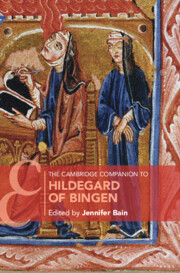Book contents
- The Cambridge Companion to Hildegard of Bingen
- The Cambridge Companion to Hildegard of Bingen
- Copyright page
- Dedication
- Contents
- Figures
- Tables
- Music Examples
- Contributors
- Acknowledgments
- Introduction
- Part I Life and Monastic Context
- Part II Writings and Reputation
- Part III Music, Manuscripts, Illuminations, and Scribes
- Chapter 10 Music, Liturgy, and Intertextuality in Hildegard of Bingen’s Chant Repertory
- Chapter 11 The Ordo virtutum and Benedictine Monasticism
- Chapter 12 Picturing Hildegard of Bingen’s Sight: Illuminating Her Visions
- Chapter 13 Hildegard of Bingen and Her Scribes
- Select Bibliography
- Index
- Cambridge Companions To …
- References
Chapter 11 - The Ordo virtutum and Benedictine Monasticism
from Part III - Music, Manuscripts, Illuminations, and Scribes
Published online by Cambridge University Press: 28 October 2021
- The Cambridge Companion to Hildegard of Bingen
- The Cambridge Companion to Hildegard of Bingen
- Copyright page
- Dedication
- Contents
- Figures
- Tables
- Music Examples
- Contributors
- Acknowledgments
- Introduction
- Part I Life and Monastic Context
- Part II Writings and Reputation
- Part III Music, Manuscripts, Illuminations, and Scribes
- Chapter 10 Music, Liturgy, and Intertextuality in Hildegard of Bingen’s Chant Repertory
- Chapter 11 The Ordo virtutum and Benedictine Monasticism
- Chapter 12 Picturing Hildegard of Bingen’s Sight: Illuminating Her Visions
- Chapter 13 Hildegard of Bingen and Her Scribes
- Select Bibliography
- Index
- Cambridge Companions To …
- References
Summary
The Ordo virtutum (the Order of the Virtues) is a sung Latin drama that Hildegard of Bingen completed c. 1152 for her newly founded community at Rupertsberg. The drama has invited a multitude of modern responses due to the originality of its language and imagery and the many possible comparisons to her own visionary and theological writing. Yet this work is firmly grounded in the theology and liturgy of the twelfth-century Benedictine convent. This chapter examines how Hildegard draws on the Benedictine rule, the rite of the Consecration of Virgins from twelfth-century Mainz, and the processional and dramatic rituals of the medieval convent to create an embodied drama of the soul’s salvation that is specific to the female monastic experience. Hildegard further emplots the struggle for the soul’s salvation in a narrative which borrows elements from the Descensus Christi ad Infernos, a fourth-century addition to the apocryphal Gospel of Nicodemus and the liturgical commemorations of its central event: Christ’s descent into, or harrowing, of hell. These texts and liturgies provide important context for understanding the dramatic situation and poetic language of the Ordo virtutum.
Keywords
- Type
- Chapter
- Information
- The Cambridge Companion to Hildegard of Bingen , pp. 235 - 256Publisher: Cambridge University PressPrint publication year: 2021



